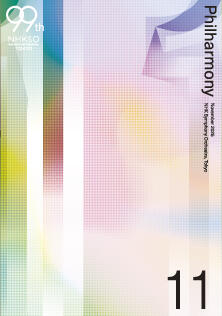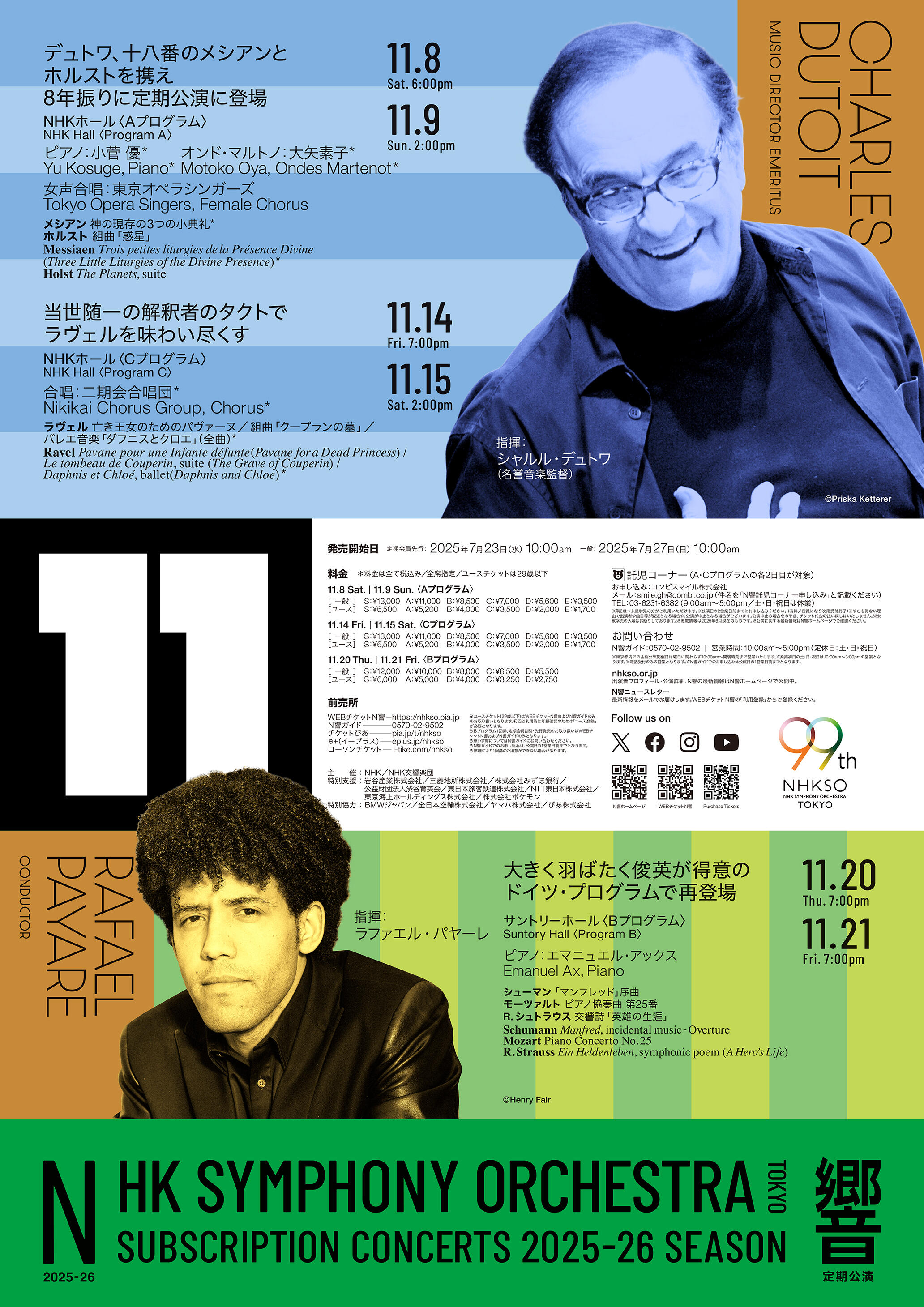- Home
- Concerts
- Subscription Concerts
- Program C
- No. 2049 Subscription (Program C)
No. 2049 Subscription (Program C)

Program
- The 150th Anniversary of Maurice Ravel’s Birth -
Ravel / Pavane pour une Infante défunte (Pavane for a Dead Princess)
The year 2025 marks the 150th anniversary since the birth of the French composer Maurice Ravel (1875–1937) whose constant clarity, minuteness and sophistication earned him a byname “Swiss Watchmaker” (his engineer father was Swiss). A keen student of Gabriel Fauré (1845–1924) at the Conservatoire de Paris, Ravel was self-admittedly influenced by Emmanuel Chabrier (1841–1894), Claude Debussy (1862–1918) and Erik Satie (1866–1925) handing down the French tradition to next generations including Olivier Messiaen (see also p. 60).
Pavane pour une Infante défunte was first composed for piano solo in 1899 when Ravel was still trained by Fauré, before the former arranged it for a small orchestra in 1910. Pavane, a slow-moving processional dance, was in vogue at European courts during the 16th and 17th centuries. One theory holds that its majestic nature is related to the name derived from the Spanish word “pavón” for peacock.
Ravel’s poetic title, likely chosen as it has a nice ring to it in French (“Infante défunte” meaning “defunct infanta”), refers to a pavane once danced by a little princess at the Spanish court. He could have been inspired by a painting of the 17th-century Spanish court painter Diego Velázquez. The composer chose a simple rondo form (ABACA) for this elegant piece full of nostalgia opened by the French horn solo giving the main tune in G major. The inner sections B and C in minor keys introduce new melodies on an oboe and a flute respectively.
[Kumiko Nishi]
Ravel / Le tombeau de Couperin, suite (The Grave of Couperin)
France’s humiliating defeat in the war against Prussia in 1871 caused a rise in patriotic sentiment among French composers, developing their admiration for French Baroque music. Four decades later when World War I broke out, Maurice Ravel at age 39, as with Debussy in his final years, renewed fascination for the nation’s glorious musical heritage as represented by François Couperin (1668–1733) and Jean-Philippe Rameau (1683–1764).
Ravel first composed Le tombeau de Couperin as a piano suite in 1914–1917 during the war, living turbulent days: he, with a surge in patriotism, joined the transport corps as a truck driver and fell ill. Then he lost his beloved mother in January 1917 before completing Le tombeau in November.
“Tombeau” (meaning tomb) was for French Baroque composers a musical form to eulogize a notable deceased person. Compared to requiem (Catholic Mass for the dead), they could communicate more freely their personal message through this secular form. Ravel pays tribute to Couperin and French Baroque music in his tombeau modeled after Baroque dance suites, and dedicates each of the six movements to his friend(s) who died in World War I.
In 1919, Ravel prepared the orchestral version omitting two highly pianistic movements (Fugue and Toccata) and changing the order of the rest. I Prélude in 12/16 time is opened by an oboe, the key instrument of the entire suite, pouring sixteenth notes out. Here we hear graceful ornaments recalling harpsichord pieces by Couperin and his French contemporaries. Marked by danceable dotted rhythms, II Forlane is especially well-endowed with modern harmonic elements including major seventh chords. Not surprisingly, Ravel had once studied Forlane from Couperin’s Concerts royaux (Royal Concerts) No. 4 for chamber orchestra making its piano transcription. The central section of III Menuet in ABA form is a musette, a pastoral dance with low sustained notes evoking musettes (French bagpipes). IV Rigaudon is also in ABA form. The outer section in C major, a lively duple-time dance originally from southern France, makes a sharp contrast with the slower central section in C minor where an oboe unfolds a melancholic folky tune.
[Kumiko Nishi]
Ravel / Daphnis et Chloé, ballet (Daphnis and Chloe)*
Russian impresario Sergei Diaghilev (1872–1929) and his ballet company, Ballets Russes, created a lively sensation in Paris in the early 20th century. Their big smashes were Firebird, Petrushka and The Rite of Spring in collaboration with Igor Stravinsky (1882–1971). Maurice Ravel was also among the artists involved in Diaghilev’s cutting-edge projects to leave us an important orchestral repertoire, i.e. the ballet score Daphnis et Chloé (Daphnis and Chloe).
The ballet was premiered in 1912. The scenario, divided in three parts, is an adaptation of an idyllic love story by the ancient Greek author Longus. It is based on the Greek legend of young Daphnis and Chloe, both brought up on the island of Lesbos. Although the set designed by Léon Bakst for the premiere was influenced by Hellenism, Ravel’s music turned away from any archaic idiom, thus representing “the Greece of my dreams close to that imagined by the French painters of the 18th century” (his own words). And the “Magician of Orchestration” meticulously and inventively brings out every instrument’s infinite potential to make the score sound gorgeous and evocative, utilizing even a wordless mixed chorus.
Part I is set in a meadow in a sacred wood on a fine spring afternoon. Introduction et danse religieuse (Introduction and Religious Dance) lets a group of young people bow before an altar of Nymphs. Daphnis and Chloé enter, and Chloé gets jealous of girls dancing around Daphnis. Now the cowherd Dorcon tries to kiss Chloé, making Daphnis vexed.
Toward the end of Danse générale (General Dance), a dance duel between Daphnis and Dorcon is proposed with a kiss from Chloé as the winner’s prize. Danse grotesque de Dorcon (Dorcon’s Grotesque Dance) and Danse légère et gracieuse de Daphnis (Daphnis’s Light and Graceful Dance) result in Daphnis’s victory. Then the shepherdess Lycéion seduces Daphnis at Danse de Lycéion (Lyceion’s Dance) during which Pirates burst into to abduct Chloé. Daphnis falls unconscious in despair. Mysterious, Nocturne lets Nymphs dance so Daphnis is revived and invoke the god Pan.
Placid Interlude with the chorus leads to Part II set in the Pirates’ camp on a seacoast. Barbaric Danse guerrière (Battle Dance) is followed by Danse suppliante de Chloé (Chloe's Dance of Supplication) where she tries to escape in vain. Suddenly, a strange atmosphere covers the place and an aeoliphone (wind machine) is heard. Pan appears, puts Pirates in horror to rout, and frees Chloé.
Part III begins with Lever du jour (Daybreak) depicting the grotto of Nymphs in the meadow at dawn. Daphnis and Chloé are reunited. At Pantomime, Daphnis as Pan and Chloé as the nymph Syrinx mime. The flowing and elegant flute solo suggests the panpipes (or syrinx), Pan’s attribute. Then the two embrace each other. Celebrating the young couple, Danse générale is the euphoric denouement of the ballet.
[Kumiko Nishi]
Artists
 ConductorCharles Dutoit
ConductorCharles Dutoit
Charles Dutoit has captivated audiences throughout the world for over six decades with his charismatic, elegant, passionate and idiomatic interpretations. He is Music Director Emeritus of the NHK Symphony Orchestra after having served as its Principal Conductor (1996–1998) and Music Director (1998–2003).
Born in Lausanne in 1936, he commenced his career as a violinist, before participating in the conducting masterclasses given by Herbert von Karajan at the Lucerne Festival. He furthered his studies by attending the legendary Ernest Ansermet’s rehearsals in Geneva. Under Ansermet’s influence, he was able to cultivate his apprenticeship of the Ballets Russes composers: Stravinsky, Ravel and Debussy. In 1959, he made his professional conducting debut with the Orchestre de Chambre de Lausanne and Martha Argerich as soloist. During his first trip to the United States, he met Pierre Monteux and Charles Munch at the Tanglewood Music School.
Former Artistic Director and Principal Conductor of the Royal Philharmonic Orchestra, he enjoyed an artistic collaboration with The Philadelphia Orchestra for thirty-two years. He was Music Director of the Orchestre symphonique de Montréal for twenty-five years and held the same position with L’Orchestre National de France for ten years. His interest in mentoring young artists has led to positions as Music Director of the Pacific Music Festival in Sapporo and the Verbier Festival Orchestra.
His latest collaboration with the NHK Symphony Orchestra took place in October 2024 when he performed the program around Stravinsky’s Rite of Spring for the NHK Music Festival. This time is his first appearance at the orchestra’s subscription concerts in eight years with two programs featuring Messiaen and Holst as well as celebrating the 150th Anniversary of Ravel’s birth.
 Chorus*Nikikai Chorus Group
Chorus*Nikikai Chorus Group
The Nikikai is an organization of singers formed in 1952 with sixteen vocalists for further promotion and development of the operatic and vocal culture of Japan. It has over 2,700 vocal members today as the country’s largest vocal institution.
The Nikikai Chorus Group, established within the Nikikai in 1953, has played an essential role at the Nikikai’s operatic performances in a variety of repertoires of different languages, including Mozart’s Così fan tutte and Le nozze di Figaro, Richard Strauss’s Die Frau ohne Schatten, Bizet’s Carmen, Wagner’s Tannhäuser and Parsifal, Handel’s Deidamia, Verdi’s La Traviata and Don Carlo, and Puccini’s Madama Butterfly. The chorus has also appeared at its own concerts as well as major orchestras’ concerts under the baton of esteemed conductors including Charles Dutoit, Gerd Albrecht, Vladimir Ashkenazy, André Previn and Eliahu Inbal.
This is the chorus’s first collaboration with the NHK Symphony Orchestra since November 2013 when they performed Verdi’s opera Simon Boccanegra (concert version) under the baton of the late Nello Santi on the 200th anniversary of the composer’s birth. This time, the chorus will celebrate the 150th anniversary of Ravel’s birth with the orchestra led by Charles Dutoit who is known as a leading specialist of the composer.
Download
Ticket
Single Tickets Release Date
Pre-sales for Subscribers:Wednesday, July 23, 2025 10:00am
*about subscribers
Sale to General Public:Sunday, July 27, 2025 10:00am
Price
| S | A | B | C | D | E | |
|---|---|---|---|---|---|---|
| Ordinary Ticket | 13,000 | 11,000 | 8,500 | 7,000 | 5,600 | 3,500 |
| Youth Ticket | 6,500 | 5,200 | 4,000 | 3,500 | 2,000 | 1,700 |
*tax included
*Subscribers receive a 10% discount (Available at NHKSO WEB Ticket and N-Kyo Guide)
*For wheelchair-accessible seats, please refer to the N-Kyo Guide
*Please note that single tickets may not be available depending on ticket price range
Youth Tickets
Youth Tickets are great options for those of 29 years old and younger
Subscription tickets
Release Date
ANNUAL SUBSCRIPTION TICKETS/
SEASONAL SUBSCRIPTION TICKETS (AUTUMN)
Sun., July 13, 2025 10:00am
[For Subscribers: Sun., July 6, 2025 10:00am]
Where to buy
NHKSO WEB Ticket | Fri., October 24 (In English / Seats not selectable on the English site)
NHKSO WEB Ticket | Sat., October 25 (In English / Seats not selectable on the English site)
NHKSO WEB Ticket (In Japanese / Seats selectable)
N-Kyo Guide (Purchase by telephone only)
Other Ticket Agents
Broadcast
 NHK-FMBest of Classic
NHK-FMBest of Classic
No. 2049 Subscription (Program C)
Friday, Nov 28, 2025 7:35PM - 9:15PM
Program:
- The 150th Anniversary of Maurice Ravel’s Birth -
Ravel / Pavane pour une Infante défunte (Pavane for a Dead Princess)
Ravel / Le tombeau de Couperin, suite (The Grave of Couperin)
Ravel / Daphnis et Chloé, ballet (Daphnis and Chloe)*
Conductor:Charles Dutoit
Chorus*:Nikikai Chorus Group
Recorded:November 14, 2025 NHK Hall
Organized by: NHK (Japan Broadcasting Corporation) / NHK Symphony Orchestra, Tokyo
*Repertoire, conductor, soloists and program order are subject to change without notice.
*Pre-school children are not allowed in the concert hall.



